From The Peopling of New York City
Interviews
Ms. Dian Dong, Associate Director of the Chen Dance Center
1. Do you live in Chinatown? If not, how long have you been part of this organization? 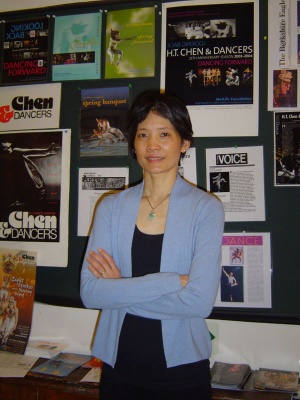
Ms.Dian Dong, Associate Director of CDC
- I do not live in Chinatown but I have worked at the Chen Dance Company, formally known as the HT Dance Company, since 1978. The company actually moved to Chinatown in 1980.
2. What is the mission of this organization?
- The mission of the Chen Dance Company is to provide moving experiences in Asian American contemporary dance through artistic creation, arts education, and presentation.
3. Who exactly do you serve? Is it solely the Asian community?
- We serve the downtown dance community. We tour a lot. We have been around the world. Later on in the year, we will be in Buffalo, Tennessee, Alabama.
4. What exactly does this organization do?
- Well, we specialize in modern dance, which is all about individual expression. We let the individual shine through.
5. How do you cope with different cultural values from the East and West?
- In China, professional arts is equated to prostitution. But this generation, we have more Western values. We are understanding and embracing the Western ways of looking at art. We use the best of both worlds. Modern art is about individual expression. There is always a better, or a different way of looking at something. Life is short, but art is long. You never want to achieve perfection.
6. How do people know that you are here?
- Most residents think that we’re only the local dance company. In fact, we have nearly 300 students. We stopped advertising because we actually have a waiting list for the classes. Our information and services are passed on through word of mouth. We have dance, music, and martial arts.
7. What are the demographics of the students and the faculty?
- We have 5 choreographers and almost 300 students. Actually, 95% of the students are Chinese. The remaining 5% are African American, Hispanic, and Caucasian. We really have an international faculty members—they are from China, US, Eastern Europe.
8. September 11th had a great impact on the entire world. How would you say this organization was before 9//11?
- Before 9/11, we were touring like mad. We were at our highest level in the 2000-2001 season.
9. How did 9/11 impact the organization?
- They were devastating three months. My students, my teachers, I couldn’t get to the studio to practice, to do anything. They couldn’t get here. There was no one to feed the fish. This place was like a ghost town. Once it started to pick up, the SARS outbreak threat happened. People thought, “Even though there were no SARS outbreak in Chinatown, this is the place people come and go from China.” The company actually ran deficits 3 years after 9/11. In 2005, we almost gave up. We had to let go of the staff. However, we have always had good art but we had to market it well. We had to think smarter and in different ways. I went to the Stanford Graduate Business School. We also used 9/11 fund grants from Chinatown Cultural Council to institute new marketing programs to boost tourism. From then on, we have been on a steady uphill climb. We have actually surpassed our pre-9/11 financial level in 2007. This year, 2008, we have done 50% better.
10. Where do you get your resources to serve the people you do?
- We offer free rehearsal space for every artist, completely new and rising artists, but the rising artists also get a commission. In order to help these artists and do what we do, we fundraise—everything from public agencies to individual contributions.
11. How do you think that Chinatown itself has changed and what to do you think the future of it is?
- Chinatown definitely hasn’t recovered. Today, it is not even 50% of what it used to be. I think people are not paying attention. Chinatown has always been bustling ethnic enclave where you can get great food. It is a safe neighborhood. People really hang on to their culture. It is filled with Chinese schools, restaurants, Buddhist temples. You here the language everywhere. Unlike other neighborhoods where the ‘residents’ don’t really live there but just have their restaurants there, Chinatown is genuine. People have forgotten that it has not rebounded completely. Chinatown is a place where people hang on to their culture. It needs a PR boost.
12. Where do you see your organization 10 years from now?
- Because we are in Chinatown, the changes that affect it, affect us too. The city is being built to quickly. Look at the crane accidents all over town. The economy is in recession, but yet, young people are the future. Businesses here aren’t with it enough to serve today’s clients. Before 9/11, there weren’t a lot of young people [who actually contributed.] They have a great product, but they don’t know how to market it well. For example, some restaurants don’t have menus that are in English. They, just like us, need smart, young people to change certain things and come back to the community. In fact, some of my own students from the ‘80s are coming back to the community and teaching. They are also bringing their children. It feels great to have ownership. In 30 years time, we have been training kids and continue to help aspiring artists. We are opening two new studios and are in the process of renovations. We have instituted new marketing ideas—we recently changed our name, we have new business cards.
Ms.Dian Dong was interviewed by Ericka Jaramillo
Interviews at the Libraries
Chatham Square Branch Library
33 East Broadway
New York, NY 10002
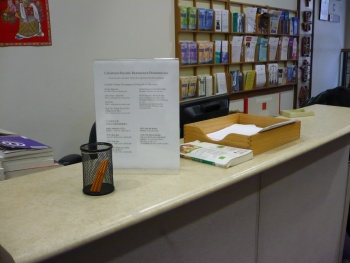
The librarian's desk at Chatham Square Library.
1. How long have you worked at the library?
2. Who uses the library mostly?
- Children and middle age people. More Mandarin.
3.What do they use it for?
- People come here to use the Internet and borrow books. Some sit and read the newspaper here. Many come to borrow DVDs.
4.Do you have any special programs such as ESL classes?
- There are ESL classes twice a week, however this is not library sponsored, they just use this space. There are Internet classes twice a month, sponsored by the library. One is in English, the other in Chinese. There are also many other activities such as reading aloud for children, films for preschoolers, and Game On @ the Library for young adults.
5.What are your hours?
- Tuesday 10 am – 8 pm
- Wednesday 10 am – 6 pm
- Thursday 10 am – 8 pm
- Friday 10 am – 5 pm
- Saturday 10 am – 5 pm
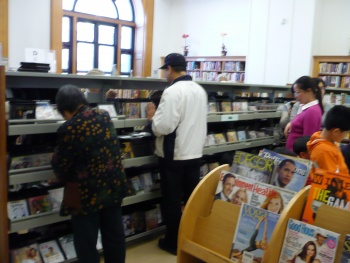
People scouring the shelves for the latest DVDs.
6.Are you targeting any group of people specifically?
- No, we do not target anyone specifically.
7.Do kids come to the library alone? With parents? After school?
- Mostly kids come alone, after school. If they are very young, their parents bring them.
8.Do people donate things to the library?
- Yes, we get a lot of book donations and tapes.
9.Have you noticed any significant changes after 9/11? More people? More people?
- There weren’t any dramatic changes after 9/11. But we began bringing Chinese DVDs so more people come now to take those out.
10.What do you think is the future of the library and more generally Chinatown as a whole, considering the new wave of immigration?
- More people will keep coming to this library, because it is at the heart of Chinatown it is very easy to pick something up or drop something off while shopping.
Seward Park Branch Library
192 East Broadway
New York, NY 10002
1. How long have you worked at the library?
2. Who uses the library mostly?
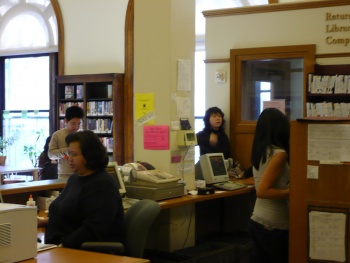
The check-out desk at Seward Park Library.
- Children of all ages as the children’s floor is always full, teens and senior citizens.
Mostly Asians, some Spanish speaking people and Russian Orthodox Jews.
3. What do they use it for?
- To take out books. Computers are very in demand because many people in this area do not have one or do not have intent access. DVDs are also very popular.
4. Do you have any special programs such as ESL classes?
- This is a very active library and so we have many activities and programs. We have Picture Book Time, Family Fun Nights, Fun with Arts and Crafts, Toddler Time, “Gadgets and Gizmos”, Teen Advisory, and Free Math Tutoring every Saturday. Each activity might be once or twice a month.
5. What are your hours?
- Tuesday 10 am – 6 pm
- Wednesday 12 am – 8 pm
- Thursday 10 am – 6 pm
- Friday 10 am – 6 pm
- Saturday 10 am – 5 pm
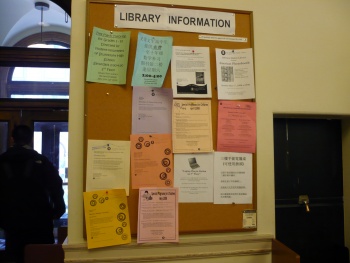
A board that displays various activities sponsored by the Seward Park Library.
6.Are you targeting any group of people specifically?
- There are a lot of children’s programs, but we are not targeting anyone specifically.
7.Do kids come to the library alone? With parents? After school?
- Kids come alone a lot after school, sometimes even during school.
8. Do people donate things to the library?
9.Have you noticed any significant changes after 9/11? More people? More people?
- Right after people came for information, about FEMA. Before this library was used mostly Jews and Hispanics. 2 out of 10 where Asians, now it is the other way around.
10.What do you think is the future of the library and more generally Chinatown as a whole, considering the new wave of immigration?
- The borders of Chinatown are growing. Before the Chinese businesses used to end at Pike Street, where you see the Manhattan Bridge but know they are coming more this way. This just means that the Chinese population is increasing and new borders are being drawn for Chinatown.
Interviews done by Angelique Petropouleas